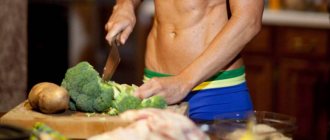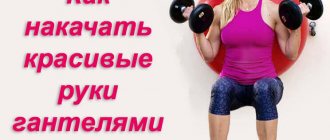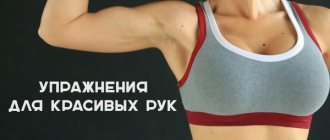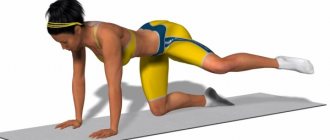You can give a beautiful shape and additional volume to your buttocks through various exercises. Squats were and remain the most effective and efficient. The main thing is to master the technique of execution. If you squat correctly and know what other exercises allow you to correct your shape, your butt will not only increase in volume, but will also become elastic. An understanding of the structure and function of the gluteal muscles plays an important role.
Anatomical features
The buttocks are formed by three posterior muscles - large, medium, small. Each performs its specific function. The large one is used when moving the legs to the sides and back, while straightening the torso, and occupies the largest area of the buttocks. The small one is located directly under the large one. Together with the middle one, they work only when the leg is abducted to the left and to the right.
The gluteus maximus muscle is most active during body extension. A similar load can be caused by doing:
- squats with weights - dumbbells or barbells;
- lunges;
- Romanian and deadlift;
- bending when a barbell rests on your shoulders.
Medium and small are involved in work when:
- swing your leg while lying on your side and from the lower block to the sides;
- leg extensions in a sitting machine;
- abducting the legs from a standing position with the machine lever.
How
So, to begin with, a brief repetition of the material already available in our hot heads. Squats are one of the most effective strength exercises for gaining muscle mass .
The movement is multi-joint and involves a large number of large and small muscles. Almost all the muscles of the lower body are included in the work when performing the exercise.
What muscles are involved?
Different movement options shift the emphasis of the load on different muscle groups. I involve classic squats with a barbell on the shoulders first of all:
- quadriceps,
- synergists (muscles that help in movement) - gluteus maximus, adductor muscles of the thigh, as well as soleus muscles,
- stabilizers - hamstrings, calf muscles,
- the load also falls on the abdominal muscles, back extensors and some other small muscles of the legs and torso .
The emphasis in the load on certain agonist and synergist muscles involved in all types of squats depends on the style of squats.
With different squat styles, the relative positions will be different:
- torso, thighs and shins at the lowest point of the seat,
- the position of the knees and pelvis relative to the projection of the general center of gravity,
- lowering into a squat and rising from it.
There are three of these styles, and they are conventionally called the “hip-dominant”, “knee-dominant” and “balanced” style of squats.
What are the benefits of squats?
Engaging multiple muscle groups is not the only benefit that exercise brings. Thanks to squats, physical fitness improves and the cardiovascular system is strengthened. If you squat regularly, not only will your buttocks change for the better, but your abdominal and back muscles will also become stronger. The pressure created in the chest during exercise improves the function of the respiratory organs, which helps saturate the body with large volumes of oxygen.
How does exercise help pump up the buttocks?
The only movement that allows you to use the large, medium and small muscles to the maximum is straightening the torso, and, therefore, squats are the best way to pump up these groups. And the lower you go, the more effective and efficient the exercise. Deep squats allow you to pump up and make your gluteal muscles elastic much faster.
Muscle strengthening occurs only when you work with weights. Training with weights helps muscles increase in volume. For each individual approach, 8-12 squats should be performed. After a cycle of repetitions, be sure to take a one- or two-minute break to rest.
You can't take light weight. The load must be noticeable. The correct choice is evidenced by the inability to perform more than 12 squats per approach. If there is no such refusal, the weights are too light. Of course, those who have never squatted with weights need to master the technique with a low load, and only then increase the weight at each session.
Squats. How to properly pump up your buttocks
Squats without weight
Air squats are used in CrossFit, but while this discipline requires performing the maximum number of repetitions in a short time, then learning the technique without equipment requires performing squats at a slow pace , concentrating on the muscles.
- Place your feet slightly wider than your shoulders and point your toes slightly apart.
- The arms are located along the body, the knees are turned in the direction of the toes.
- As you inhale, begin to slowly squat until parallel to the floor or just below your knees (if the flexibility of your ankles and the muscles of the back of your body allows).
- As you move, raise your arms straight up in front of you, aligning them in line with your torso.
- Do not bring your knees forward beyond your toes, stabilize the position of your shins. Keep your back and abdominal muscles toned without leaning your body forward.
- At the bottom of the squat, transfer your body weight to your heels; this technique will load the gluteal group, removing excess stress from the spine (especially when working with weights).
- Exhale, push through your heels and rise up, keeping your abdominal muscles tense.
Technique for performing squats with a barbell
You need to do the exercise technically correctly:
- The bar, located in a special power frame, is positioned at the level of the shoulder girdle. They approach the bar with their backs, and the bar is placed on the upper area of the trapezoid. It is forbidden to place the load on the vertebral sections of the neck. This is extremely dangerous.
- The barbell is removed from the rack and a couple of steps are taken forward. The legs are placed so that they are the width of the hip region. The socks can be spread slightly apart or placed strictly parallel to each other. The chin is kept slightly raised, which allows you to look up.
- Slowly squat while inhaling. The hips are lowered so that the knees do not extend beyond the toes, since this negatively affects the knee joints, but form a strictly right angle. The back is kept straight, the shoulder blades are brought together, the gaze is directed upward, the elbows are directed slightly back.
Important! You cannot round your lower back or move your body forward too much. The tailbone must be pulled back, because without this the muscles will not stretch and, therefore, grow in volume.
- With the force of the gluteal muscles, as you exhale, they rise upward, but faster than descending. The knees are straightened, the torso is extended. Having returned to the starting position, you should not completely straighten your knee joints, as this will remove the load from them.
Technique
For women and girls - “pelvic dominant” style
This squat technique is suitable for those who want to emphasize the load on the hip extensor muscles - gluteal, ischiopopliteal (back of the thigh), adductors (only the back of the adductor magnus muscle).
Important: everything written below is absolutely relevant and valid for squats with any weight and without weight: with dumbbells, with a kettlebell, with an elastic band, with a bar, with a bodybar,
This glute squat will definitely benefit you! In addition, the spinal extensor muscles are strongly involved in the work (due to the forward tilt of the torso, which is an integral element of this technique, these muscles are forced to work hard in a static mode, keeping the spine in an extended state, i.e., the back is straight).
Of course, this particular style is suitable for targeted increases in strength, mass and volume of the gluteal muscles , as well as for progressing results in the squat, be it the maximum weight lifted or the number of repetitions with a certain weight.
The hip-dominant style of squatting allows you to maximize the use of strong gluteal muscles and not overload complex and unstable knee joints (most powerlifters squat in a “hip-dominant” style).
Important point : in any case, you will swing quadra, in any type of squats. Yes, when performing a squat, you can turn off the quadriceps... no way. Humble yourself. If your trainer/favorite fitness girl/public page on VK says the opposite, you should know that he is shamelessly lying!
Please note that a rounded butt always comes with legs. If this does not happen, 99% that these are implants/gels/synthol, etc. This is anatomy, it is useless to argue with it: either the butt and legs - or neither one nor the other.
To pump up your buttocks
The pelvis will go back and down , accordingly, the body will lean forward strongly , and the knees, when bending, will remain in place or move slightly forward - a position in which the shoulder of the barbell’s gravity will be greater for the hip joints and, accordingly, most of the “extension weight” when standing up from the seat will take over the hip joint, or rather the muscles that extend it (gluteal, ischial-popliteal).
It is very important to sit down correctly : in the starting position, the pelvis should be slightly tilted back due to the deflection in the lumbar spine . The movement begins with the pelvis moving back and down, due to the synchronous flexion of the hip and knee joints, synchronously with the torso tilting forward.
A common mistake when lowering into a squat is to concentrate on moving the pelvis as far back as possible (especially if in the initial position it is not initially set back), bending the hip joints accordingly and tilting the torso forward, while forgetting the need to bend the knees synchronously with the tilt of the torso.
The result is not squats, but bends with a barbell on strongly bent legs:
In principle, due to the individual characteristics of the body structure, the forward tilt of the torso in “hip-dominant” squats can be very large – up to 45* degrees to the vertical at the bottom point of the squat.
If you have enough mobility in the hip joints and the strength of the spinal muscles to keep your back straight (or better yet, arched in the lumbar part), then this is acceptable.
But if, with such a strong torso tilt, the thighs do not even reach parallel to the floor at the bottom of the squat, this is a direct consequence of the knees not bending, and this, by definition, cannot be called a squat.
The hip flexion in a hip-dominant squat will usually be greater than the knee flexion, but in any case it should be synchronized . The support is on the heels, and not on the entire foot.
Rising from a squat begins with extension in the hip joints using the force of the gluteal muscles with synchronous extension of the knees. When straightening your knees before straightening your torso, you will not get up from sitting, but straighten your legs with a lift of the pelvis, while increasing the tilt of your torso, and then you will have to unbend as if you were bending over again with a barbell on your shoulders.
How much do you need
How many squats do you need to pump up your butt? The question is too vague and the answer to it will be the same: we don’t know. Keep in mind one fact: muscle growth is a long and persistent process; there will be no significant gain in a month or 2 (and this is subject to ideal nutrition + training).
Expect to get results after half a year/year of regular, varied training for your Madame Siju.
For men - “knee-dominant” style
This squat technique focuses on the muscles that extend the knee joint - the quadriceps, and also significantly engages the muscles of the back of the lower leg (the gastrocnemius, and especially the soleus). As a rule, such squats with a barbell become a choice for men.
On the left is a knee-dominant squat, on the right is a hip-dominant one. The difference is obvious.
Suitable for a targeted increase in the volume, strength and mass of the hips with a minimal increase in these parameters of the gluteal muscles (hardly any girls are interested in this). So it’s often the guys who squat in this style.
How to focus on legs
In this style, the pelvis should go down vertically or with a slight shift back, the body should tilt forward slightly, and the knees should extend forward far beyond the line of the toes.
The focus should not be on bending the knees and pushing them forward, but on lowering the pelvis that was initially set slightly back (due to the lumbar deflection) and the straight torso vertically down (the torso will inevitably lean a little forward - the main thing is not too much) - the knees they will go ahead on their own.
The downward movement of the pelvis when lowering should be strictly vertical or downward and inclined slightly backward (but in no case forward), the center of gravity falls exactly on the middle of the foot (support on the entire foot).
Lifting is carried out by straightening the knees using the force of the quadriceps. The pelvis and vertical torso (almost vertical - with a minimal forward tilt) just as they went down into the squat - straight down, they rise in the same way - straight up.
In “knee-dominant” squats - when the torso is slightly tilted forward, you need to focus on the extension of the knees, and extension in the hip joints will occur naturally - when the torso moves up and maintains balance and a constant center of gravity (in the middle of the foot).
Balanced
This style is accordingly characterized by a more or less balanced use of all muscles involved in squats and an absolutely natural nature of movements for the body.
What squats help you quickly and effectively increase your butt size at home?
Every girl can become the owner of beautiful and firm buttocks. The main thing is to set a goal and train regularly. It is not even necessary to visit the gym and exercise under the strict guidance of a trainer. You can also train at home. The exercises below, as well as important tips and tricks, can help you with this.
Classic with own weight
They are supposed to work exclusively with their own weight. Aimed at working the quadriceps, major, and adductor muscles. Without the use of weights, the lumbar extensors and core receive minimal load. It is a mistake to believe that the lack of load makes squats easier and simpler.
They are difficult for an unprepared person, since they are the most difficult exercises in physical education. It is certainly much easier to squat with your own weight (without weights), and even a beginner can easily master the technique. This allows you to tone your muscles so that after some time you can move on to working with a barbell.
Classic squats should be performed by those who need to prepare themselves for a serious load and understand the correct technique. This exercise is not suitable for pumping up your buttocks. It only tones the muscles, but does not increase volume.
Deep
They are a squat in which the pelvis is lowered so that it forms an acute angle at the knees, that is, it is below the level of parallel to the plane of the floor. This allows you to load both medium and large muscles well. Additionally, the work includes the adductors, lumbar, abdominal muscles and quadriceps. Thanks to a deep squat, it is the buttocks that are loaded, since they are the first to start working when lifting.
The range of motion increases, which increases tension and effort in the muscle fibers. And if the classic version does not give growth, then a deep squat, on the contrary, allows you to pump up your buttocks well. Not everyone can squat deeply. If your ankles are not flexible enough, this exercise will not be possible.
With a narrow stance
The legs are placed shoulder width apart. Close placement of the feet will not provide a stable position, so they must be slightly spread apart. Thanks to this pose, the middle and large, quadriceps, lumbar, adductor and abdominal muscles work. This squat allows you to optimally use the glutes, but it is only suitable if you have flexible ankles and ligaments, good length of the torso and hips.
For some, due to their physiological structure, it is difficult to squat from this position. If difficulties arise, then place your feet a little wider or turn your toes slightly. This allows you to achieve stability and properly load the muscles. The main thing is that while squatting, your thighs should be horizontal at the lowest point.
Sumo
Wide squats (sumo) work the adductor magnus, gracilis, middle and major quadriceps muscles. And if in a classic squat the adductor femoral muscles are minimally involved, then in this exercise they receive a significant load. This squat variation is not recommended to be performed in isolation. It should be done in combination and not on a regular basis, as it causes the inner thigh to increase in volume.
Curtsy
Cross lunges or curtsies are another variation of the squat. Its action is mainly aimed at the muscles of the buttocks medius and maximus and the quadriceps. The semimembranosus, semitendinosus, dorsal, abdominal muscles, as well as the hamstrings receive a small load.
The curtsy is a great addition to a leg training program. There are many different variations of cross lunges. They help to perfectly stretch the gluteal muscles. The only point is that the joints must be very flexible to perform such a squat.
With a kettlebell or dumbbells
The technique is no different from classic squats performed with a barbell. Similar muscle groups are involved. A significant advantage of dumbbells and kettlebells is that there is no compression on the spine. The use of these weights makes it possible for those who suffer from injuries and displacement of the vertebrae, osteochondrosis, intervertebral hernia, that is, cannot squat with weights on the shoulder area. This makes kettlebell dumbbells a great alternative to barbells.
"Plie"
This version of the squat got its name for its similarity to ballet technique. The exercise loads the adductor femoral, gluteus medius and gluteus maximus muscles. The work involves the quadriceps, abdominal muscles, and lower legs. To perform a plie squat, you need to have a fairly flexible hip joint.
The advantage of the exercise is that the quadriceps are not overloaded. However, given that the training is aimed at growing the buttocks, squats in this technique must be performed technically correctly. Lowering and lifting should be carried out not through the hips, but through the buttocks; it requires good concentration on the movements.
Deep on one leg or “pistol”
An excellent option for good development of the gluteal muscles. Working with your own weight allows you to provide an excellent load, but does not require the use of any additional sports equipment or equipment. Performing a pistol requires physical training. It is almost impossible for a beginner to master such a squat, so it is done when the muscles are already sufficiently prepared.
The greatest load falls on the large and quadriceps muscles. The downside is that such a squat is quite traumatic for the knee joints. This imposes certain restrictions. People suffering from pain or any problems with their knees should not do the pistol exercise.
With a barbell
Working with free weights during squats, if the technique is one hundred percent correct, allows you to make your buttocks firm and beautiful better than any other type of physical activity. Form formation occurs much faster when muscles serve as stabilizers, providing balance. The barbell option is contraindicated for people suffering from pain and spinal injuries.
Smith machine
An excellent squat machine that can replace the barbell option, but only temporarily. By working out in a Smith machine, you can prepare yourself for a real load in order to form a strong muscular corset and master the technique of using a barbell.
This makes the machine a great bridge between bodyweight, dumbbell, kettlebell, and shoulder-weighted squats. A simpler execution is achieved by relying on the bar and a stable position of the body with the knees, which allows you to properly load the quadriceps and glutes. You can squat in the machine with any position of your legs.
Learning to squat correctly
First, let’s look at the technique of performing the “classic squat” exercise, with or without a barbell. We recommend that you re-read the general nuances again, because below we will present an algorithm where these recommendations are included by default (that is, we will not rewrite them again, but this does not mean that they do not need to be followed).
Classic
- Stand straight, your lower back can be slightly protruded, keep your arms extended in front of you or place them on your sides;
- Lower yourself down until your thighs are parallel to the floor;
- Rise up, keeping your back straight.
The barbell is held on the shoulders, trapezius muscles and rear deltoids. Hands rest on the bar, shoulder-width apart. In a squat, the pelvis must be pulled back; when lifting, the body straightens.
Frontal
When doing front squats, the bar is held on the chest, on the front deltoids. Grab with your palms facing away from you, with your elbows parallel to each other;
- Starting position – feet shoulder-width apart, toes turned outward by 45°;
- Slowly lower yourself down, then, without jerking, immediately rise up smoothly, using the power of your quadriceps;
- Don't lean forward. Depth – up to parallel. Watch your posture.
Narrow staging
Next, we’ll find out how to squat correctly at home with a narrow leg stance. This exercise allows you to effectively load the outer surface of the thigh, which means it is extremely useful in the fight against riding breeches.
- Starting position – legs narrower than shoulder width, distance between feet – 10-15 cm;
- Start slowly squatting until your knees are at a 90° angle;
- At the same time, the body leans forward, but the back remains straight;
- When you reach the bottom, push through your heels and lift yourself up.
Wide stance
Want to know how to squat properly to effectively target your inner thighs, glutes, and quads? The most popular types of squats in this category are plie and sumo. In plie, the socks turn out to the sides as much as possible, while the width of the position is not maximum. In the sumo technique, the legs are placed as wide as the stretch allows, and the toes can be turned outward to the middle position.
- Take the starting position, if necessary, place a barbell on your shoulders (you can take a kettlebell or dumbbell and hold it with straight, lowered arms between your legs);
- As you inhale, slowly lower yourself down until your thighs are parallel to the floor;
- As you exhale, rise up.
Lunges
To squat properly, you need to know a variety of techniques, including learning how to do lunges. They are the closest relatives of squats and have an equivalent effect on the lower body.
- Starting position – feet shoulder-width apart, arms on your sides (or holding the bar or dumbbells correctly);
- As you inhale, step forward with one leg, keeping your torso perpendicular to the floor;
- The body weight is transferred to the front leg, the back one stands on the toe;
- Start squatting so that the knee of the front leg forms a right angle with the thigh, and the back leg practically touches the floor;
- As you exhale, come back, switch legs and repeat the cycle.
Bulgarian
Next, we will find out how to place your legs correctly when squatting using the Bulgarian method, in which one leg is placed back on the bench. You need to squat on one working leg, you can use weights.
- The back remains straight throughout all stages, and the knees do not move forward too far;
- During a squat, the shin of the working leg remains perpendicular to the floor;
- As you inhale, lower down to the maximum, as you exhale, rise up;
- Change your legs.
If you are interested not only in how to do squats correctly, but also in how many times, follow these recommendations: without weights, you should squat at least 50 times, 3 repetitions. With additional weight, do 10-12 squats, 3 repetitions. Listen to your feelings, focus on your own physical fitness. You should not squat if you feel pain, dizziness, or weakness. Rule out any contraindications.
We looked at the technique of performing the most basic squats, beloved by many trainers. We have provided you with basic recommendations for successfully studying it. However, keep in mind that to tighten your buttocks and thighs, starting to squat correctly will not be enough. It is important to follow a training schedule, eat right, regularly increase the complexity and use these exercises in combination with others. To put it more clearly, when pumping your butt, don’t forget about your stomach and arms. Forget about fast food, don't be afraid of the barbell and remember the benefits of walking. Especially up the stairs! And, of course, don’t forget to squat - wherever the opportunity arises.
A set of squats for buttocks for 30 days
It consists of increasing the load every week, but at the same time reducing the number of repetitions in four approaches:
| Approach 1 | Approach 2 | Approach 3 | Approach 4 | |
| 1 Week | 20 | 15 | 12 | 12 |
| 2 week | 15 | 12 | 10 | 10 |
| 3 week | 12 | 10 | 10 | 8 |
| 4 week | 12 | 10 | 8 | 8 – 6 |
How to pump up your butt. Butt workout
Reasons for the absence or presence of muscle pain after training?
Any physical activity causes the muscles to feel tension, accompanied by microscopic tearing of the fibers. Unprepared muscle groups, as a rule, begin to hurt the next day after training. Painful sensations are in no way associated with lactic acid or lactate entering the gap. The latter stops after a maximum of four hours, and the pain does not go away until several days. The cause is the crack itself, that is, injury to the muscle fiber.
Proper loading is not accompanied by pain from rupture. Its complete absence also does not indicate the effectiveness of the training. Regular exercises gradually dull the discomfort of pain. When such a moment comes, it means it’s time to move on to heavier loads, but, of course, not excessive ones. Otherwise the pain will occur again.
How to choose the right weight of weights?
It is best to start squatting with your own weight. If possible, it is better to practice until the technique is fully mastered, under the guidance of a good trainer. The load is increased gradually. First you should take an empty bar. When the knees begin to remain motionless and the body does not fall forward, the weight is increased.
Weights should be chosen so that you can not only stand and squat with them, but also climb. You should add no more than 5 kg, and not every session. If 12 repetitions are easy, increase the weight, but reduce the number of repetitions slightly.









